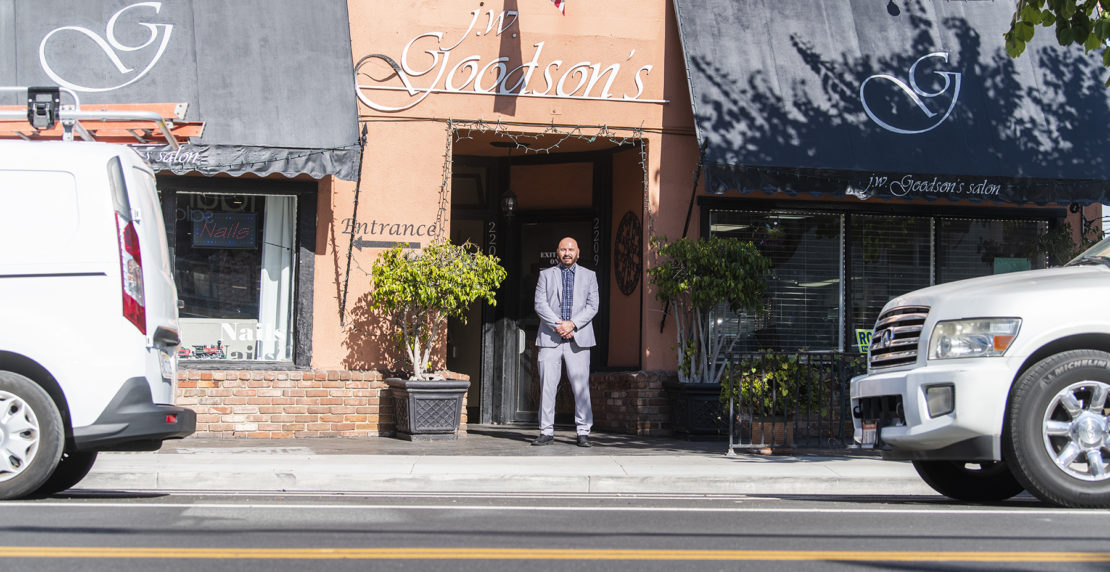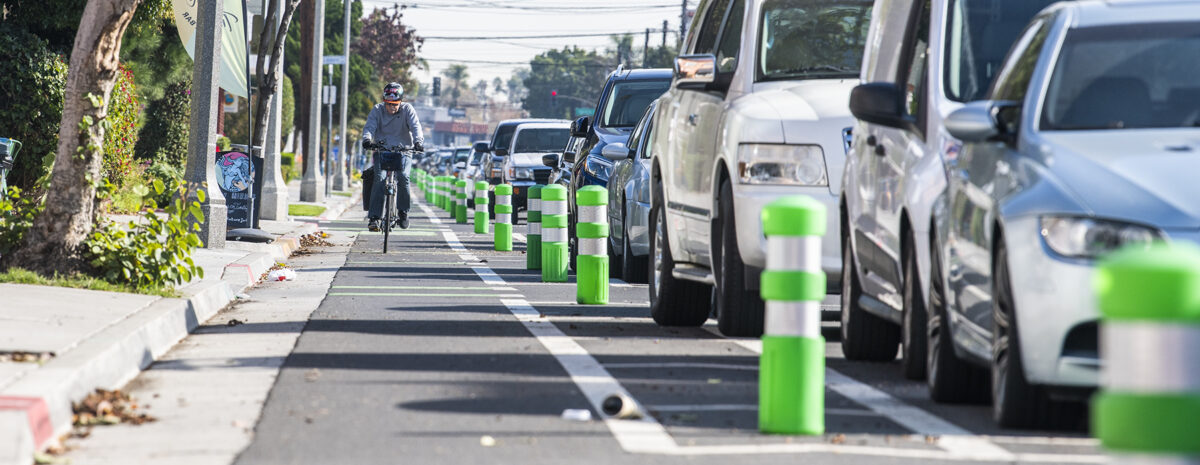Ken Davis admits it; when he first heard about the Broadway “road diet,” heard that it would create more parking and better flow, he was optimistic, even enthusiastic about what it would mean for businesses on the street, including his coffeehouse, Hot Java.
“When we first got word about it years ago during the Broadway corridor meetings, they talked about what they were going to do: create more parking spaces, even floated the idea of getting a bump-out for more seating. We were excited.”
What he and his fellow shopkeepers got, he said, was “the exact opposite.” Less parking, less flow and such a drop in business—Davis says he’s down 40%—that many are wondering if they’ll survive.
“When they started lining [the street for the road diet] you could instantly see that this was not going to be what they talked about,” Davis said. “There was no parking for customers and no loading zone for my suppliers. Every day I’d see a little more and think, what the hell is going on?”
In an effort to make the street safer, Broadway underwent a “road diet” earlier this year that’s resulted in fewer cars and slower traffic along the thoroughfare, something shopkeepers like Davis say is putting them out of business. The Measure A-funded East Broadway Corridor Project stretches from Alamitos to Redondo avenues and reduces the street to one lane in each direction with inner bike lanes between the curb and parked vehicles. About 30 parking spaces also were eliminated.
City officials estimate the cost for work done in the roughly 2-mile section was between $3 and $5 million. In the city’s most recent traffic study, conducted this fall, westbound traffic volume decreased 30% and eastbound decreased 26% compared with the same time period in 2016. Westbound traffic speed for 85% of vehicles was reduced to 32 mph (from 35 mph in June 2017), and eastbound speed was reduced to 33 mph (from 36 mph). The speed limit is 30 mph.
Jennifer Carey, executive assistant for Public Works, said the new traffic volumes are more consistent with other residential-zoned areas and similar-sized streets in the city. The city has not provided updated collision statistics or a bicycle count for Broadway.
“The primary goal was to improve safety, so make it safer for pedestrians, bicyclists and vehicles,” Carey said. “Part of that goal was to slow down vehicles along the corridor and reduce traffic volume … We accomplished what we set out to do.”
But Davis says the efforts to slow down vehicles really only redirected them somewhere else.
“When [the road diet] first came, I immediately noticed morning backups on other streets, like Third,” he said. “And I thought, oh no, they are consciously avoiding Broadway.”
That’s what Broadway’s holiday-ready shopkeepers, including one who is planning to close her business, say the city’s efforts have cost them customers. Many who participated in a protest of the project this summer said their continued complaints are going unheard and they haven’t seen any improvement since then.

“Business is down 40%,” Hot Java’s Davis said about the decline the nearly 30-year-old business has experienced. “We lost all of our morning traffic from people who used to run in and get their coffee because they have nowhere to park in front of our building.”
Frustrated by a perceived lack of response and communication from city officials—”We don’t feel like there has been honest communication. There’s more rumors on this street than facts”—Davis said he and more than 1,000 other business owners and area residents have signed a petition stating that the reconfiguration is “dangerous to the public and detrimental to businesses.” It asks the city to restore lost parking spaces and widen the lanes.
Walter Ordonez, the owner of the beauty salon J.W. Goodson’s, started a “Broadway Legal Defense Fund” on GoFundMe to raise money for a legal fight against the city—if that’s what it takes—to fix the roadway and compensate impacted businesses. Shop owners and residents collected $6,000 before the webpage was set up, he said, and they’re hoping to raise at least $25,000 through the official fundraiser.

“Our political representatives have ignored our concerns and our pleas to correct these issues. We intend to be heard and fix this problem in the courts,” Ordonez said, noting that he’s seen zero walk-ins for beauty services since the road diet, and he was forced to layoff one of the salon’s receptionists.
Both business owners said customers and employees complain about the lack of street parking and the poor visibility when turning onto Broadway or when trying to pass vehicles that have blocked traffic, and they both shared concerns about not having any handicap parking near their storefronts. Davis also said his delivery drivers don’t have a loading zone they can use to drop off goods.
Even harder hit is businesswoman Merry Colvin, whose boutique is up for sale and will likely close at the end of January. Colvin likes to say one little neighborhood storefront is all it takes to make the world a better place, and she opened Merry’s, an Eastern bazaar-style shop, back in 2006.
“I love my store, but there are no customers in here today and it’s been like that—it’s been horrible,” Colvin told the Long Beach Post, noting that she’s unable to pay the rent—even in a strong economy. “The road diet is putting me out of business. I never saw myself leaving, but I cannot stay.”
She said customers who used to stop on Broadway for a coffee at The Firehouse or dinner at Gallagher’s would often walk around and into her store, but that’s not happening anymore.
“The dynamic of the street has changed,” she said. “I’m down minimally 50%, but it’s probably more like 70%. My regulars don’t want to drive on the street. They are avoiding Broadway and the stores here.”
Colvin said she’s called everyone at City Hall, but she hasn’t been satisfied with the response: “They think it’s great and they keep saying, ‘Oh you’ll get used to it.’ It’s so condescending. I’m furious.”
And despite the fact that District 2 Councilwoman Jeannine Pearce (who did not respond to requests for comment) and city staffers have said the public was notified about the scope of work, Colvin and other business owners said the project in its current form was not communicated.
“We had meetings for years and came up with a phenomenal Broadway Visioning Plan, and we all thought we were getting three lanes with diagonal parking on one side, better lighting, more bulb outs…” Colvin said.
Davis agreed. He thought the city was installing head-in parking and a sidewalk bump (or bulb out) to expand his patio space: “We were really excited, but this was 100% a surprise how this turned out.”
In response to criticism about not including diagonal parking, Carey said Broadway simply could not accommodate that and a bike lane, so officials had to prioritize. Other planned improvements, including bulb outs, may be added later as funding sources are identified, she noted.
Park Pantry manager Tammy Centanni also said she’d been looking forward to what she thought would be fresh pavement and extended sidewalks outside the diner. What’s happening instead, she said, is a serious problem going unaddressed.
“I’ve let the city know about some of the issues we’re having, and they haven’t done anything about it,” she said.
Business has slowed so much at Park Pantry that she hasn’t been able to give her team the hours they’re asking for and she’s concerned about losing good employees.
“It’s not fair for the city of Long Beach to do this to these businesses,” Centanni said. “We’ve been here for 60 years, and they should care.”
Carey said Public Works would continue to collect data and make necessary adjustments to the project, and several changes already have been made since the summer based on feedback from area business owners and residents. Those recent changes include: the removal of about half of the installed curb stops (low plastic barriers), giving cars more room to park; more visible paint on the street; adding loading zones in front of businesses that requested them; reducing the size of various red zones; and eliminating street sweeping hours by using a smaller machine to only sweep inside the bike lanes.
“We don’t have a real efficient way of counting exactly how many parking spaces we’ve added,” she said. “We did quite a bit of manipulating to see how we could add that space back.”
Business owners said they haven’t noticed any changes at all or that the changes haven’t been enough. Carey, who personally drives that corridor to and from work every day, said she believes people are adjusting to the road diet.
“Any time you implement a large change like this, people are going to be unfamiliar with it and it’s going to be a hard transition,” Carey said. “No one likes change. I don’t like change. But as everyone starts adjusting to it and getting used to it and familiar with it, we do see that the concerns and the complaints drop, and that is what we’ve seen on Broadway as with other projects in the city.”
She said the city doesn’t currently have any plans to put Broadway back the way it was before the road diet, but she said the Public Works department takes all concerns seriously and will continue to evaluate and improve the thoroughfare.

